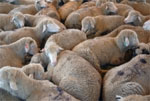
Environmental Groups Sue FDA Over Livestock Pharm Rules
Last year the FDA proposed in a draft guidance that the agricultural industry voluntarily restrict use of in antibiotics in livestock. This draft suggestion caused an outcry on both sides of this contentious debate: Environmentalists didn’t think the suggestion went far enough to protect consumers and the environment, while livestock producers recoiled at what they saw was the FDA overstepping its bounds. You know you’re dealing with a contentious issue when both sides are outraged at a draft of a suggestion.
The agency has yet to issue a final version of the guidance, and it appears some environmental and heath groups are getting tired of the delay: Yesterday, several of these groups filed suit against the FDA to try to get the agency to ban the widespread use of penicillin and tetracycline in livestock.
Without getting into all the legal wrangling – if you’re interested, see this story for an excellent history – the groups are alleging that the FDA decided that the practice was harmful in 1977, and that since then it has unlawfully failed to act on this health threat.
I was shocked to see just how big of a practice this is: Livestock, a 2010 FDA study revealed, consume 80 percent of the nation’s antibiotics, with penicillin and tetracycline comprising 32 percent of that total. In real numbers, that’s huge quantity – 7.3 million pounds.
But we’ve gotten used to cheap food prices. Americans dole out a smaller portion of their income for their food than most nations, and inexpensive food has become something that we expect. I know I’m upset when I go to the store to find that yogurt now costs eight cents more than it once did.
On the other hand, it does make me a little uneasy to slice up an “all natural” chicken breast that’s bigger than a steak and serves three. But I keep buying it, because organic chicken breast is, in my mind, prohibitively expensive. From a global perspective, were all farmers to switch to organic methods, they would be unable to feed the world’s burgeoning population, so an all-organic switch would prove insufficient as well.
So what is one to do amid all this confusion? Sometimes it seems as if the only right answer is planting a huge garden in your backyard and eating only from that. But that’s completely impractical. What do you think – should the FDA ban the use of these two antibiotics in livestock? What kinds of food choices are the right ones – for the environment, for our families, for our health?
Posted by Laura Williams on May 27, 2011